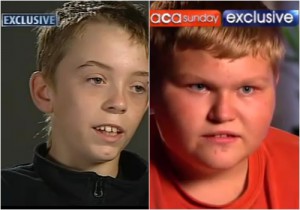If you’ve ever been bullied growing up, then you’ll no doubt immediately empathize and cheer for Casey Heynes, the 16-year-old Australian high school student who not only stood up to one of his many bullies, but pile-drove him into the ground.
Heynes lit up the internet when a video of him fighting back against a 7th grade student by the name of Ritchard Gale was posted on YouTube. Since then Heynes, who has been lovingly dubbed “Little Zangief” by the masses after the famous Street Fighter video game character who also happens to share the same move list with Heynes, has become something of a poster child for anti-bullying. The original video has also spawned a plethora of YouTube remixes championing the eloquent high school student for the brave soul we all wished we could be in school and beyond.

If you haven’t watched these interviews yet, I highly recommend them because I think they give a very real insight into what it’s like for victims of bullying not just in Australia, but all over the world. I’m not a psychiatrist by any sense of the word, but I did grow up in a very tough part of California where the kinds of shenanigans that Heynes went through were probably as prevalent if not more so for me in my neck of the woods.
Heynes retelling of his life lends much credibility to his story. As mentioned earlier, Gale, in his interview, not only accuses Heynes of starting the confrontation, but also that he wasn’t sorry for attacking Heynes. Now certainly we probably should discount some of Gale’s more outlandish statements as being a product of nervousness from being interviewed, however we shouldn’t give him too much of a break because in my experience that’s how bullies get away with all the things they do.
First from an objective perspective, Heynes is not only older and bigger than Gale, but he’s also about four grades ahead of him. Now put yourself in Gale’s shoes for a moment: if you had all these things going against you and Heynes was as popular and/or intimidating as you claimed he was, would you really go and try to knock him out? Let alone do a mockingly Muhammed Ali-like jig before landing each blow? Certainly not. Gale is no doubt the bully in this matter.
Growing up, I saw and met a lot of kids like Gale. They always had excuses and were more vocal then and also a lot better at discounting their victims in front of tired teachers and administrators who usually just turned a blind eye to the problems. The only downfall for Gale this time is that his crocodile tear filled story doesn’t fly too well on a national scale.
Secondly, Heynes himself is incredibly well-spoken for someone his age. This is counter to many bullies because it shows a level of maturity and introspection that typically goes hand-in-hand when a person grows up in social isolation. Heynes states that all his friends had abandoned him early on in his adolescence, leaving only his sister as his primary confidant. On top of that, both Heynes’s parents and his teachers claimed to be ignorant of the bullying. All of this lend even more credibility to Heynes’s account.
But I probably didn’t need to go into as long of an analysis for you guys to not only believe Heynes’s story, but also that I’m probable more or less right about how the bully-victim relationship works. After all, you all were kids at one point and whether you were a bully or a victim, you know how the game works and you also know that little has changed for kids today. That’s why I find it so funny that parents, the news media, and school administrators are acting so surprised in regards to Heynes’s story.
I mean, is it really all that surprising that someone like Heynes was being bullied? “The quiet portly kid with no friends is a victim? No way…” Of course way! Go into any classroom for the day and observe the students at work and play, I guarantee you that you’ll be able to pick out the victims and bullies before school lets out. It doesn’t take a doctor to tell you how easy it truly is, meaning the tragedy is that instead of doing something, every adult just put their head in the sand instead.
There really is an easy solution: legislate a law that requires teachers and school administrators who are close enough to the problem to intervene. Okay, I know that sounds like a terribly difficult proposition, but hear me out. Schools should be required to put out anonymous drop boxes, either in person or online, where students can report bullying. In addition, teachers and administrators should proactively resolve disputes through early intervention using mediation by way of a neutral third party (like a guidance counselor). The mediations should be weekly or more for at least one school year; this will force the students to actually work out their issues rather than fake it through a one-time mediation. And if you’re concerned about teachers and administrators overstepping a student’s rights, don’t be because lest you forget minor students have limited rights compared to full-fledged adults.
Of course there is always the possibility that this won’t work or make things worst for a victim. And this is certainly a valid concern, however if nothing happens to correct the problem, is that really better than possibly finding a way to fix it?
What our clients think
At LegalMatch, we value our client’s opinion and make it a point to address their concerns. You can refer to our reviews page if you want to know what our clients have to say about us.